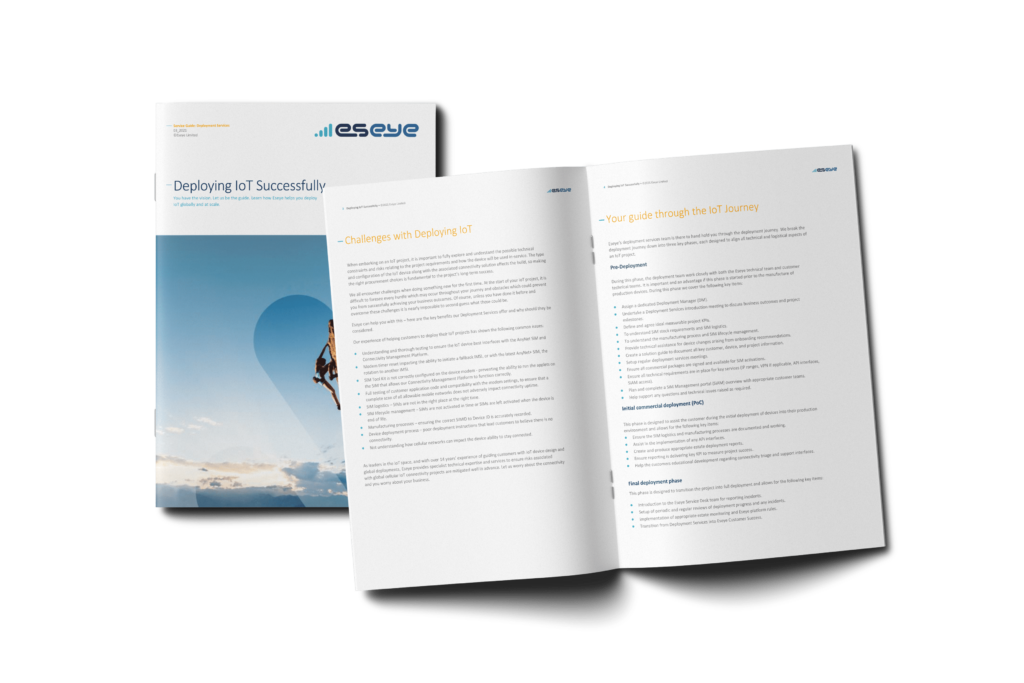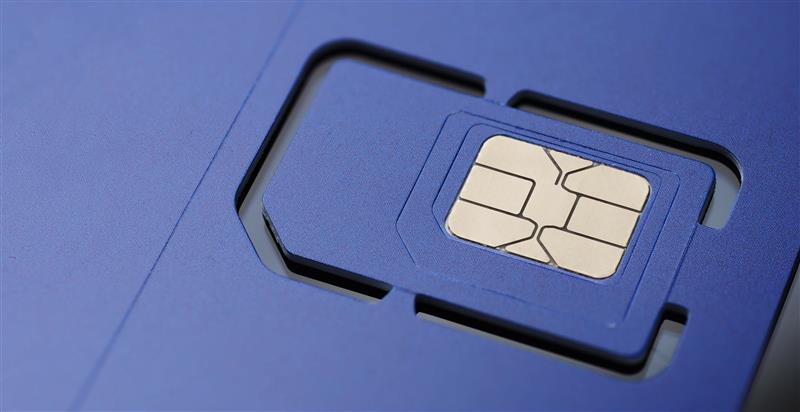Of all the different types of digital transformation, IoT must be a contender for Most Challenging. From integrating cybersecurity into highly constrained devices and making non-replaceable batteries last a decade, to finding actionable value from data collected from thousands of devices in a global deployment, the demands are as varied as they are challenging.
A smooth, successful IoT deployment requires significant work before devices start rolling off the production line. And before data collection and analytics can begin, there’s a load more work to ensure smooth device installation, connectivity and management.
Fortunately, there is a way to lighten the load. Partnering with experts on IoT device design and connectivity frees up the business to do what it does best – focusing on the data.
Preparing for success
Our article on why you need IoT strategy and advisory services explains why many IoT projects fail and how to avoid the common traps that befall many businesses looking to reap the benefits that IoT can bring.
Once the business case and strategy are clearly defined, it’s time to address the key preparatory steps in the journey to achieving success:
- Connectivity requirements
One of the most critical pieces for IoT is connectivity – without it, any IoT project is a non-starter. And yet, even with the reliability and availability of cellular networks, there’s no guarantee of global, ubiquitous connectivity for IoT devices – for that, you need experts in device design and connectivity provision.
How devices will connect to the cloud or data centre drives many critical decisions, so it’s important to address this early. Factors to consider include where devices will be located, whether they’re fixed or mobile, data transfer requirements, expected lifetime, and requirements for low power networks.
- Security requirements
Security for IoT devices is the number one concern for many enterprises. Challenges include device and user authentication, data encryption, over-the-air updates, security for data traversing the internet, and storing and managing data, security parameters and applications on the device.
- Device design and prototyping
IoT devices must supply the right data, meet physical and environmental constraints, operate smoothly with the chosen connectivity platform, and be secure and easy to operate. A well-designed device is ready for rigorous testing in proof-of-concept and field trial phases.
Learn more about designing IoT devices that work and the requirements you need to meet >
- Onboarding
Ensuring that devices work with your chosen connectivity provider is critical before starting the rollout of your deployment. Sophisticated connectivity solutions can download new network subscriptions and switch devices to different networks over-the-air. Ensuring that these systems work successfully with your devices in the field requires thorough testing, as described in Why IoT Device Onboarding is Important.
- Certification
In our article What is IoT device certification?, we explain how IoT devices often need to meet a raft of certification and regulatory requirements. This is a key stage that can take substantial time and expertise to complete successfully.
What goes into an IoT deployment?
With your device ready for mass production, there’s more to do before you trigger the manufacturing and deployment process:
Manufacturing and logistics
Managing the manufacturing and distribution of IoT devices requires careful planning to ensure that the right number of devices is available at the times and places required. If a phased deployment is planned based on performance of devices or other criteria, there must be a timely mechanism for triggering manufacture of additional batches.Manufacturers must accurately record the mapping of SIMs to devices to enable the devices to be managed in the field. They must also perform rigorous end-of-line connectivity testing.
Network security provisions
Connectivity providers must implement any network security provisions required before go-live. This can include managing security certificates for devices, implementing a Virtual Private Network (VPN) for protecting data traversing the internet, and adding Access Control List (ACL) rules to firewalls to manage non-VPN data.
Device management
The lifecycle and expected behaviour of the devices determines how they should be managed. Here are four questions you should consider:
- When should SIMs be activated? Ideally, production testing should not use activated SIMs, but sometimes this is required. Whatever the timing requirements, the commercial and technical arrangements must be in place to allow SIMs to be activated successfully.
- When should SIMs be deactivated?You need to know when devices have reached end-of-life or are out of use to avoid incurring service charges unnecessarily.
- How much data will devices send and receive? Alerts should be configured to trigger when devices exceed – or fail to meet – thresholds so that issues can be investigated promptly.
- How are devices managed remotely?For example, sending a reset command to an unresponsive device to force it to reboot or suspending a device that exceeds data thresholds and incurs unexpected charges.
Estate management
Deployments of thousands – or hundreds of thousands – of devices require optimised estate management processes. Sophisticated connectivity platforms provide a single pane of glass management for deployments, with in-depth reporting facilities to understand individual and aggregated behaviour. With APIs, you can integrate monitoring and management data into your own systems and tools.Device connection and data metrics for global traffic flows can provide key insights into performance across different regions and operators. Analysis of this data highlights trends, patterns, problems, and anomalies, and enables increasingly automated responses to ensure optimum performance of the estate.
The Eseye IoT deployment service
Eseye is a leader in the IoT space and has experience of delivering more than 2000 IoT projects over 15 years. We have the expertise to guide you all the way along the IoT journey, helping you to avoid pitfalls and enabling you to achieve the benefits of a successful deployment.
Our service starts with appointing a Deployment Manager to become part of your team. Throughout the process, the Deployment Manager will work with you to achieve the agreed milestones and resolve issues that arise.
Our deployment service has three phases.
Pre-deployment phase
During the pre-deployment phase, we review the status of your project and put in place the provisions required for the deployment to start. For a typical deployment project, we will:
- Work with you to develop a plan with key milestones and KPIs for your deployment project.
- Review the onboarding report to understand your device and its expected behaviour. If the onboarding process identified issues, we check that these are resolved and retest the device if required.
- Check that all certification and regulatory requirements have been addressed.
- Assist with API integration if required.
- Provide training in Eseye’s monitoring and management tools.
- Implement the technical and commercial provisions required for device activation and connectivity.
- Configure alerts and reports as required.
Initial commercial deployment
When preparations are complete, the initial deployment can commence. Some businesses use a phased deployment strategy, installing small batches of devices for proof-of-concept (PoC) purposes and increasing gradually to full deployment. Others are ready to trigger full rollout straightaway. For a typical deployment project, whether a PoC or the start of a full deployment, we will:
- Liaise with manufacturers and distributors to ensure that the production process operates smoothly and that devices are shipped to the required locations at the right times.
- Verify that API integrations are working successfully, and your staff can operate Eseye’s monitoring and management tools to generate the reports to support KPI measurements.
- Verify that alerts and reports are working as required.
- Provide support for any glitches arising from unexpected device and connectivity issues.
- Continue to train and transfer knowledge to your team.
Final deployment phase
The aim of the deployment service is to establish a process that runs smoothly, with manufacturers and distributors meeting their requirements and devices going live without issues. The final deployment phase ensures that, with teething issues resolved and a stable process in place, you will be able to smoothly scale your deployment now or in the future.
As part of this phase, we will:
- Review and document the deployment process, lessons learned and best practices.
- Ensure that a change management process is in place.
- Verify that monitoring and management rules are operating as expected.
- Check that alerts and reports enable efficient management and provide metrics for ongoing KPIs.
- Manage the transition to our support teams.
- Deliver the deployment solution guide to provide you with the information you need for continued scaling and future deployments.
Post-deployment support
Our teams continue to work and support your deployment into the future, offering you peace of mind that the connectivity of your devices is under our expert care.
After each successful deployment with Eseye, we provide you with a deployment solution guide which outlines detailed findings from our work, including any agreed processes or specific information related to your deployment. Eseye’s Service Desk and Customer Success teams use this document as the basis for the support service, so they have all the relevant information for supporting and optimising connectivity for your estate.
With standard and bespoke support plans available, you have access to our highly experienced team who will work closely with you to ensure a swift resolution to any issues.
Eseye were incredibly easy to work with and were with us every step of the way from initial designs right through to deployment and ongoing technical support.
– Steven Whitaker, COO

A customer’s deployment experience
Spidertracks, a leading provider of satellite aircraft tracking, fleet management and communication solutions, looked to Eseye to provide a cellular connectivity solution to supplement their satellite communications.
With the lower cost of sending cellular data, Spidertracks could collect significantly more data, enabling both better real-time incident responses and the in-depth analytics necessary to gain powerful insights from the rich datasets.

Our IoT Deployment Service
In this guide, we share our knowledge and expertise from 14 years of deploying IoT, to help you minimise risk and overcome challenges in the three key phases of any IoT deployment journey:
- Pre-deployment
- Initial commercial deployment (PoC)
- Final deployment
Anand Gandhi
SVP Worldwide Sales
Anand has over 20 years of technology experience within large global, medium, and start-up organisations, including senior positions held with Cisco, Vizolution, and Diebold Nixdorf.
